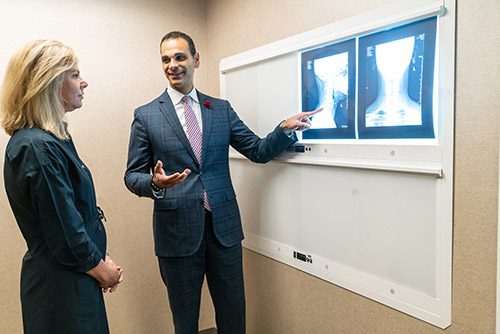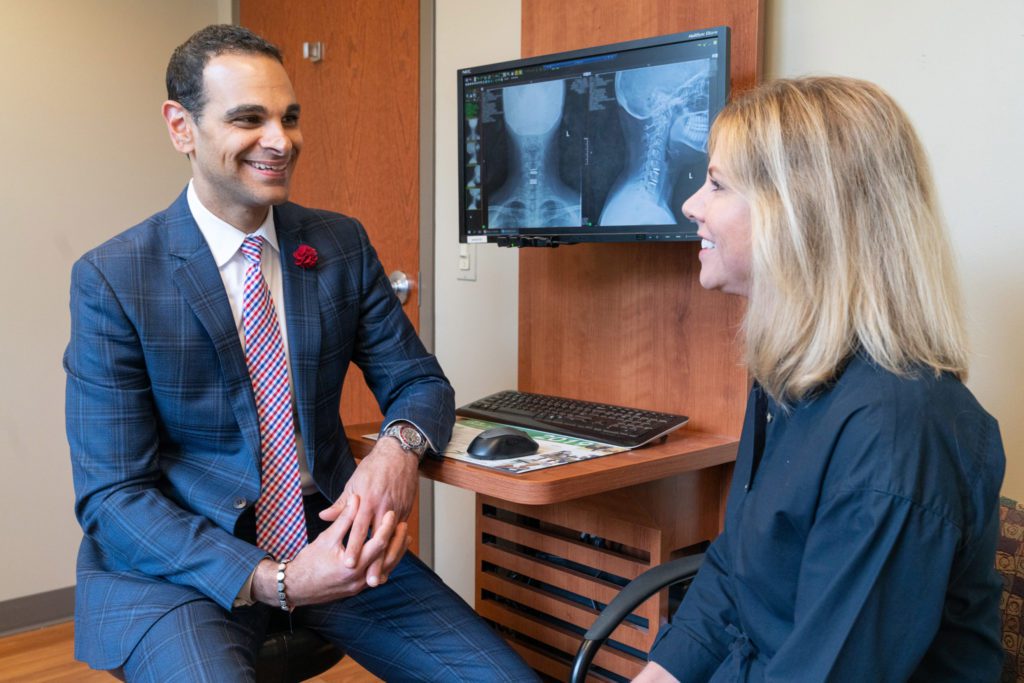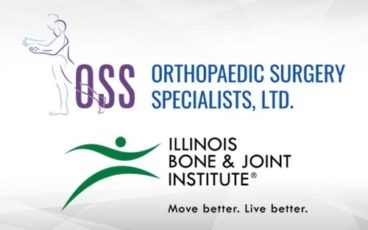Written by Bob Bong, Community Health Magazine
Illinois Bone & Joint Institute (IBJI) is taking a more modern approach to treat patients with damaged cervical disc-related neck pain.
Cervical disc arthroplasty is a relatively new surgical procedure in which degenerated or herniated cervical discs are replaced with artificial devices. The procedure is used to treat chronic, severe pain resulting from degenerative disc disease or disc herniation.
Cervical disc arthroplasty has been performed in the United States for roughly the past 15 years, says Mark Mikhael, MD, an orthopedic surgeon at IBJI, and who has performed between 50 and 75 of the surgeries over the past four years. The procedure, which takes an hour or less, is an alternative to spinal fusion surgery, which until the FDA’s approval of intervertebral disc arthroplasty in 2004 was the only method to relieve neck pain caused by damaged discs.

“The outcomes are about the same,” Mikhael says, referring to arthroplasty versus fusion. “But fusion prevents the bones from ever moving again and can limit the patient’s mobility.”
Fusion requires removing the affected discs and grafting the cervical vertebrae together to stabilize that portion of the spine. It can put pressure on the remaining vertebrae, which can lead to similar disc problems in the future.
“There also is a potential for recurrent problems using fusion,” Mikhael says. “There’s a 30 percent lesser chance for recurrent problems using cervical disc arthroplasty.”
Ann Sciortino says the procedure has been life-changing. Ann, 50, of Wilmette, underwent the procedure in February and could not be happier with the results.
For years, she endured crippling pain caused by a degenerative disc. The condition took away her active lifestyle and made something as simple as sleeping an excruciating ordeal.
Three weeks after the surgery, she was cleared to resume all her regular behaviors.
“I’m active again,” she says.
Perpetual Pain
Symptoms of a damaged or herniated disc can include neck pain or stiffness; pain that radiates from the shoulder to the arm and hand; weakness in the shoulders, arms or legs; and numbness or tingling in the arms and fingers.
Ann had been suffering from the degenerative disc and resulting pinched nerve in her neck for more than two years. The pain caused by the condition radiated down one arm. For Ann, sleeping was almost impossible.
“I would toss and turn all night long,” she recalls. “I couldn’t find a spot that was not painful. I felt like a rotisserie chicken spinning all night.”
She tried physical therapy and received surgical epidural shots, which provided limited relief and didn’t last. She also continued to experience tingling in her arm.
Complicating Ann’s neck surgery was her history of post-operative problems with pain management. She survived breast cancer twice and underwent a double mastectomy. But she learned from those experiences that she can’t take commonly prescribed pain-relieving medications.
“Pain meds don’t work for me,” she says. “Most of them make me ill and do nothing.”
Ann turned to IBJI for relief and has not regretted the decision.
“Dr. Mikhael and my pain management doctor said I was a good candidate for the arthroplasty procedure,” she says. “It was the best thing I ever did. I’m incredibly grateful.”
Mikhael says he is confident Ann will be able to remain active for as long as she chooses to be.
“The replacement discs will outlive her,” he says.
Rapid Recovery

Cervical disc arthroplasty requires a small incision to be made in the front of the neck. The affected disc or discs are removed through this incision and replaced with the artificial devices, which are sized for the patient to ensure a proper fit.
The advanced medical technology of arthroplasty lessens the effects of surgery, reduce recovery time, and contributes to fewer follow-up visits and subsequent procedures.
“Patients who get cervical disc arthroplasty are up quicker, and there’s less physical therapy and less surveillance X-rays to make sure the bones are healing,” Mikhael explains. “Shorter stays are less costly. And the patients are back to their normal activities faster.”
Arthroplasty puts the focus on technology, he adds.
“The replacement disc allows the bone to retain its natural range of motion for rotating the neck and looking up and down,” he says. “The patient is upright right away, there’s no need for a neck brace or collar, no limitations on movement.”
Mikhael acknowledges cervical disc arthroplasty is not for every situation and says there will always be a need for spinal fusion. Patients with advanced arthritis, distorted anatomy, neck fractures or traumatic injuries are not good candidates for arthroplasty, he says.
It is, however, ideal for younger patients, he adds.
“There’s no doubt in my mind it’s the right procedure,” he says. “It gives patients their life back.”
Ann was anxious enough about the procedure that she called Dr. Mikhael the Friday before her surgery. Mikhael was understanding of her concerns and did everything he could to ease her worries.
“I’m super grateful,” she says. “They went above and beyond to make me feel comfortable before the surgery. He talked me through the procedure again. I felt like a partner in my care.”
And now?
“I’m literally pain free,” she says. “I feel like I did 20 years ago. It had been so long since I was pain free. I’m learning to play tennis and I’m back kayaking. I’m pretty active again.”




